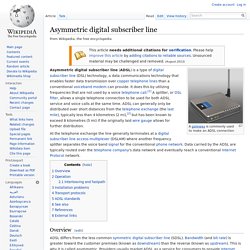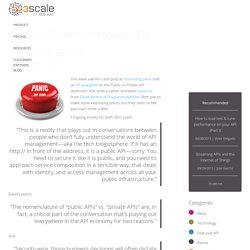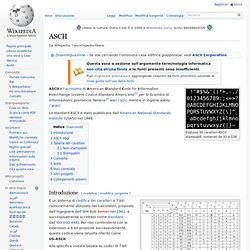

Account. Da Wikipedia, l'enciclopedia libera.

Un account, in informatica, indica quell'insieme di funzionalità, strumenti e contenuti attribuiti ad un nome utente in determinati contesti operativi, spesso in siti web o per usufruire di determinati servizi su Internet.
AllJoyn. AllJoyn. AllJoyn is a system that allows devices to communicate with other devices around them.

A simple example would be a motion sensor letting a light bulb know no one is in the room it is lighting, so it can shut itself off. The AllJoyn software framework and core system services let compatible devices and applications find each other, communicate and collaborate across the boundaries of product category, platform, brand, and connection type. Target devices include those in the fields of Connected Home, Smart TV, Smart Audio, Broadband Gateways, and Automotive.[6] Qualcomm is working on providing OEM solutions. Currently, the communication layer (and thus hardware requirements) is limited to wi-fi.[7] Though the protocol started at Qualcomm, they have signed over the source code to the Linux Foundation. Technology[edit] The system uses the Client–server model to organize itself.
The system also has technology for audio streaming to multiple device sinks in a synchronized way.[15] Hyperlink. Internet of Things, IoT. ACPI - Advanced Configuration and Power Interface. Advanced Configuration and Power Interface. In computing, the Advanced Configuration and Power Interface (ACPI) specification provides an open standard for device configuration and power management by the operating system.

First released in December 1996, ACPI defines platform-independent interfaces for hardware discovery, configuration, power management and monitoring. Advanced Configuration and Power Interface. Da Wikipedia, l'enciclopedia libera.

La specifica Advanced Configuration and Power Interface (ACPI) è uno standard industriale aperto reso disponibile per la prima volta nel dicembre 1996 e sviluppato da HP, Intel, Microsoft, Phoenix e Toshiba. Essa definisce interfacce comuni per il riconoscimento dell'hardware, la configurazione e la gestione energetica di scheda madre e periferiche.
Secondo la sua specifica, "L'ACPI è l'elemento chiave nella configurazione e gestione energetica controllata dal Sistema Operativo (OSPM)". L'ultima revisione della specifica ACPI è la 6.0, diffusa il 27 aprile 2015[1]. Introduzione[modifica | modifica wikitesto] L'elemento più importante dello standard, la gestione energetica, ha avuto due miglioramenti importanti. What is ACPI? Webopedia. ADSL. Asymmetric digital subscriber line. A gateway is commonly used to make an ADSL connection.

VDSL. Very-high-bit-rate digital subscriber line. This VDSL modem used in Taiwan provides 4 Ethernet ports and an internal filter for voice-data separation.

Second-generation systems (VDSL2; ITU-T G.993.2 approved in February 2006) use frequencies of up to 30 MHz to provide data rates exceeding 100 Mbit/s simultaneously in both the upstream and downstream directions. The maximum available bit rate is achieved at a range of about 300 meters; performance degrades as the loop attenuation increases. Development[edit] The concept of VDSL was first published in 1991 through a joint Bellcore-Stanford research study.
The study searched for potential successors to the then-prevalent HDSL and relatively new ADSL, which were both 1.5 Mbit/s. Hyperlink. V, acronimi informatica. Definitions & Terminology, Networks. Application programming interface. Da Wikipedia, l'enciclopedia libera.

Caratteristiche[modifica | modifica sorgente] Le API sono essenziali per i computer come gli standard elettrici lo sono per una casa. Chiunque può inserire la spina del tostapane nella presa a muro della sua casa o dal vicino perché entrambe le case sono conformi ad uno standard. Se non ci fosse una interfaccia standard, occorrerebbe avere una centrale elettrica per fare un toast. Public vs Private vs Internal APIs. This week saw Kin Lane post an interesting piece over at API evangelist on the Public v’s Private API distinction that drew a rather animated response from David Berlind at ProgrammableWeb.

Both pieces make some interesting points, but they seem to talk past each other a little. Forgiving brevity for both, Kin’s point: ASCII. Da Wikipedia, l'enciclopedia libera.

Esistono 95 caratteri ASCII stampabili, numerati da 32 a 126. ASCII è l'acronimo di American Standard Code for Information Interchange (ovvero Codice Standard Americano[1] per lo Scambio di Informazioni), pronuncia italiana[2] asci /ˈaʃʃi/, mentre in inglese askey /ˈæski/. Lo standard ASCII è stato pubblicato dall'American National Standards Institute (USASI) nel 1968. Accelerated processing unit. Da Wikipedia, l'enciclopedia libera.

Hyperlink. Apprendere l'informatica, HW section. CPU, processore. Arch User Repository (AUR) Per iniziare Assicurarsi di aver isntallato il gruppo base-devel (pacman -S --needed base-devel).Leggere il resto di questo articolo per ulteriori informazioni e un breve tutorial su come installare i pacchetti AUR.Visitare il sito Web di AUR per informarsi riguardo agli aggiornamenti ed agli eventi. Lì troverete anche statistiche ed una lista aggiornata delle ultime versioni disponibili per i pacchetti di AUR.Dare un occhiata alle #FAQ in cerca di risposte alle domande più comuni.Modificare il file /etc/makepkg.conf per ottimizzare al meglio le priorità del tuo processore per la compilazione dei pacchetti da AUR. Un significativo miglioramento nei tempi di compilazione può essere ottenuto, con i processori multi-core, impostando correttamente la variabile MAKEFLAGS.
Gli utenti possono anche abilitare ottimizzazioni specifiche per l'hardware in GCC attraverso la variabile CFLAGS. Vedi makepkg.conf per ulteriori informazioni. Storia. Assembly language. Assembly language is converted into executable machine code by a utility program referred to as an assembler. The conversion process is referred to as assembly, or assembling the source code. Assembly time is the computational step where an assembler is run. Different. Machine code. Machine code or machine language is a set of instructions executed directly by a computer's central processing unit (CPU). Each instruction performs a very specific task, such as a load, a jump, or an ALU operation on a unit of data in a CPU register or memory.
Every program directly executed by a CPU is made up of a series of such instructions. Numerical machine code (i.e., not assembly code) may be regarded as the lowest-level representation of a compiled or assembled computer program or as a primitive and hardware-dependent programming language. While it is possible to write programs directly in numerical machine code, it is tedious and error prone to manage individual bits and calculate numerical addresses and constants manually.
It is thus rarely done today, except for situations that require extreme optimization or debugging. Hyperlink. M, acronimi informatica.